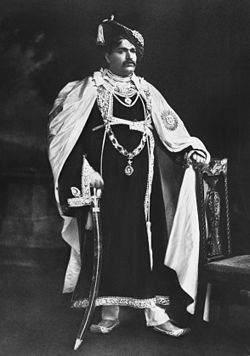Shahu of Kolhapur
| Shahu / शाहू | |
|---|---|
| Rajarshi Shahu Maharaj of Kolhapur | |

Portrait of Rajarshi Shahu Maharaj of Kolhapur(1912)
|
|
| Reign | 1884–1922 |
| Predecessor | Shivaji VI |
| Successor | Rajaram III |
| Born | June 26, 1874 |
| Died | May 6, 1922 (aged 47) |
| House | Bhonsle |
| Father | Appasaheb Ghatge |
| Mother | Radhabai |
| Religion | Hinduism |
Shahu(also known as Rajarshi Shahu Maharaj or Chhatrapati Shahu Maharaj) GCSI GCIE GCVO(June 26, 1874 – May 6, 1922) of the Bhonsle dynasty, was Raja(reign. 1884 – 1900) and Maharaja(1900-1922) of Indian princely state of Kolhapur.
Shahu was born on June 26, 1874 as Yeshwantrao Ghatge, eldest son of Jaishinghrao Ghatge, chief of Kagal(senior) by his wife Radhabai, daughter of Raja of Karnataka. He was adopted by Anandibai, widow of Raja Shivaji VI, in March 1884. Several generations of inter-marriage had ensured that Shahu's family was connected intimately with the ruling dynasty of Kolhapur, which is apparently what rendered him a suitable candidate for adoption, despite his not being a male-line member of the Bhosale dynasty. He was educated at Rajkumar College, Rajkot. A council of regency was appointed by the British Raj to oversee affairs of state during Shahu's minority and during that time, he was tutored in administrative affairs by Sir Stuart Fraser. Shahu was invested with ruling powers upon coming of age in 1894.
When Brahmin priests of the royal family refused to perform the rites of non-Brahmins in accordance with the Vedic hymns, he took the daring step of removing the priests and appointment a young Maratha as the religious teacher of the non-Brahmins, with the title of Kshatra Jagadguru(the world teacher of the Kshatriyas). This was known as the Vedokta controversy. It brought a hornet's nest about his ears, but he was not the man to retrace his steps in the face of opposition. He soon became the leader of the non-Brahmin movement and united the Marathas under his banner.
...
Wikipedia
